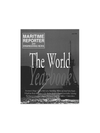
Page 90: of Maritime Reporter Magazine (June 1999)
Read this page in Pdf, Flash or Html5 edition of June 1999 Maritime Reporter Magazine
Communication Technology
Ready for the year 2000?
Computer date problems are going to affect
GPS users as early as this August. But
Inmarsat is preparing for the millennium bug, having set up a task force to deal with it as far back as 1996, writes Ruth Ling.
Anyone working in indus- try or commerce who does- n't yet know how the Year 2000 problem could affect them is painfully unaware of the world around them.
Originally seen as just an
IT problem, the millenni- um bug is now recognized as a business issue with much wider implications, the greatest one being busi- ness survival. Potentially, the problems associated with the use of two-digit year fields — 00 appearing as 1900 rather than 2000, and 2000 being a leap year — will affect all software and embedded micro-processor chips which have any awareness of or dependency on dates. A whole new Year 2000 industry has sprung up in the past year or so. Those companies which are tak- ing the problem seriously are investing enormous sums of money in IT expertise to take precau- tionary measures. SingTel,
Singapore's signatory to
Inmarsat, for example, is spending a total of $100 mil- lion to beat the bug. The brain-drain of the 50s, when
British skills and intellect were lured overseas, is being repeated as British programmers are offered salaries of $8,000 a day and free flights home on the Concorde every weekend by American companies determined to be Year 2000-compliant. But the maritime industry has not woken up to the threat of the millennium bug and
Lloyd's Register of Shipping has warned of the poten- tial seriousness of complacency: "The shipping indus- try is making a late start. There could be problems with embedded chips in navigational, propulsion and safety equipment such as fire detectors and alarms," said Tim
Jones, chief executive of Lloyd's Register.
Consequently, Lloyd's and insurers Thomas Miller have developed an Internet web site (at www.lr.org/links/index.html) to alert both equipment suppliers and ship-owners of the need to check all their systems. And union leaders have voiced their con- cerns, saying the industry has a history of reacting only after a tragedy.
But steering a passage through these choppy waters is Inmarsat, which is preparing itself for whatever the turn of the century might do to the world's clock-based computer systems. The organization set up its Year 2000 task force in November 1996, and within two years the vast majority of its mission-critical systems have been tested for year 2000 compliance.
The task force is headed by Gill Govier, manager of the programs management group, part of the product development and engineering division at Inmarsat, and a member of the ITU's prestigious Year 2000 task force. The team includes people working across all divisions — from technical and satellite control to financial and administrative, including health and safe- ty and payroll — to ensure service and business conti- nuity.
Key objectives of Year 2000 task force
In 1996 Inmarsat carried out an inventory and risk assessment of all its systems. Its aim was to ensure all its key systems are compliant with the year 2000 date change so that they will be able to: • handle date information before, during and after Jan- uary 1, 2000, including, but not limited to, accepting date input and performing calculations on dates or por- tions of dates; • function accurately and without interruption before, during and after January 1, 2000 without changes in operation associated with the advent of the new centu- ry; respond to two-digit year date input in a way that resolves the ambiguity as to the century in a disclosed, defined and pre-determined manner; store and provide output of date information in ways that are unambigu- ous as to century; manage the leap year occurring in the year 2000 following the quad-centennial rule. In
Maritime satellite communications - expensive but necessary. Make that, "used to be." For a limited time,
KVH K2/K3 Tracphones from Stratos are just $999.
WHAT YOU GET
K2/K3 Tracphones are designed for marine use.
Operating over the AMSC satellite and built compact for installation below decks, they come equipped with reliable, fully stabilized marine antennae and
RS232 (4.8 kbps) data ports for PC users. Cabling is included - 18 feet for K2s and 150 feet for K3s.
So act fast. The offer ends August 31,1999.
HOW TO GET IT
Call Stratos and order your K2/K3 Tracphone today.
You'll get all the information you need about installation and airtime pricing (priced separately). Certain condi- tions may apply. A 2-year service contract and other conditions may apply.
Call now! 1 -888-332-4444 92
Circle 279 on Reader Service Card "The Yearbook" Maritime Reporter/Engineering News

 89
89

 91
91
